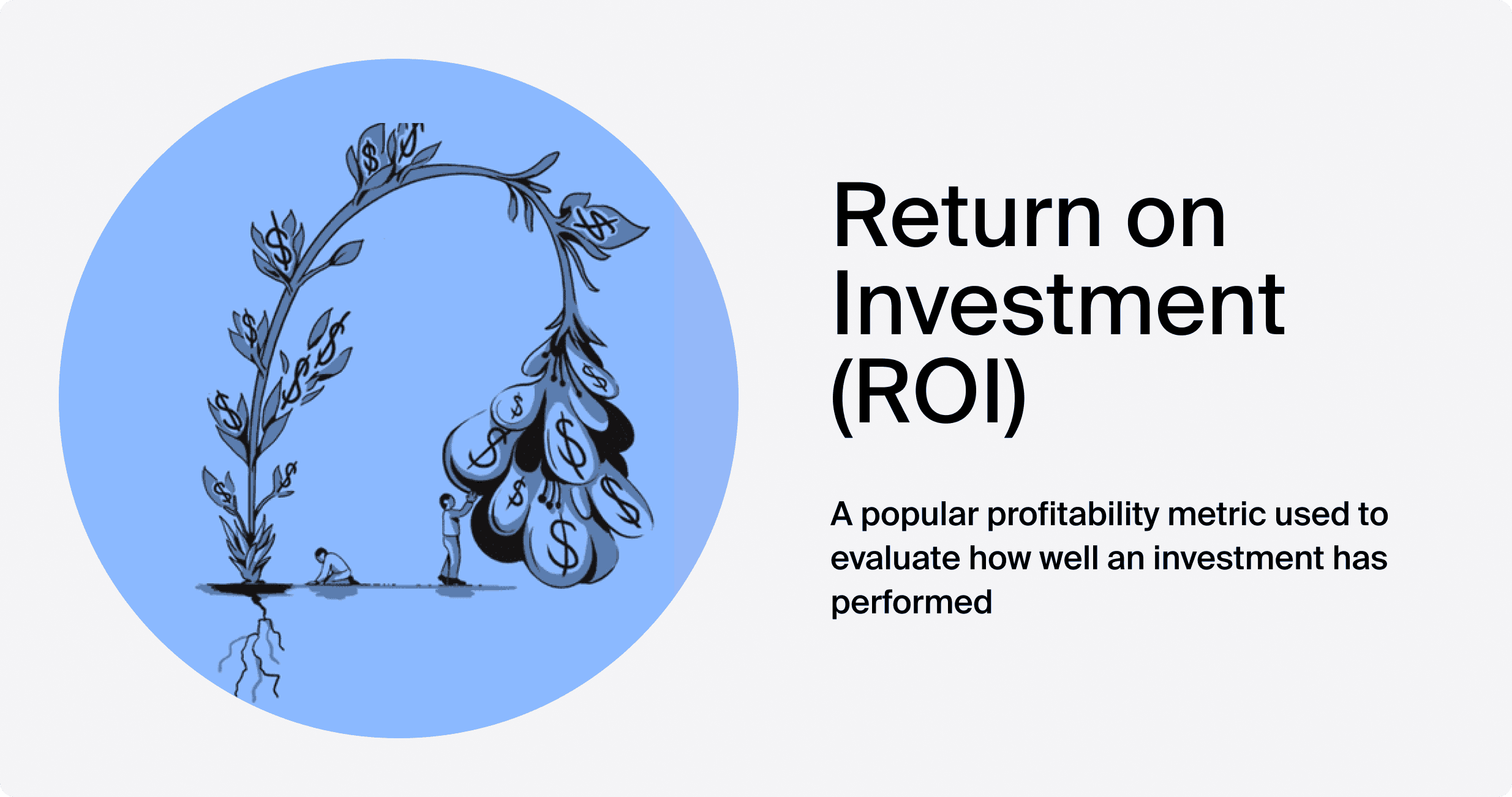Return On Investment, How To Calculate?

Understanding and effectively utilising Return on Investment is paramount for businesses and investors alike. Return on Investment or ROI serves as a barometer for evaluating the profitability and efficiency of investments. In this article, we will explore ROI meaning, the benefits of it while acknowledging its limitations. Additionally, we will provide insights on how to calculate ROI, steps to enhance it, and alternative metrics tailored to the specific demands of the market.
What is ROI?

Return on Investment (ROI) is a financial metric that evaluates the profitability of an investment. It is expressed as a percentage and represents the ratio of net profit to the initial cost of the investment.
What Are Pros of ROI?
Pros of ROI include:
- Simple and Easy to Calculate: ROI's simplicity is a distinct advantage. Its straightforward formula is easy to understand and compute. This simplicity facilitates quick assessments, allowing businesses to make informed decisions without the need for complex calculations.
- Universally Understood: ROI is a universally recognised metric, transcending industry boundaries. In a diverse market, where sectors vary from mining to technology, the universal understanding of ROI enables consistent evaluation and comparison of investments across different industries.
- Comparative Analysis Capability: One of the strengths of ROI is its ability to facilitate comparative analyses. This allows companies to benchmark their performance against industry standards, helping identify areas for improvement and strategic adjustments.
What Are Cons of ROI?
Here are cons of ROI:
- No Risk Adjustment: One limitation of ROI is its inability to account for risk. In the market, where external factors can impact investments, ROI may not fully capture the associated risks. Investors and businesses need to complement ROI with additional risk assessment tools for a comprehensive view.
- Some Costs May Be Omitted: ROI focuses on easily measurable costs, potentially omitting some hidden or intangible expenses. In case of arising unforeseen costs, relying solely on ROI may lead to an incomplete financial picture. A thorough cost analysis is essential.
- Some Issues May Be Ignored: Not all issues affecting investment success may be reflected in ROI. For instance, social or environmental factors might not be fully captured. A broader assessment, including social ROI, may be necessary for a comprehensive analysis.
- Inability to Consider Time in the Equation: ROI doesn't account for the time value of money. Not factoring in the time element could lead to suboptimal investment decisions. Businesses should consider using metrics like annualised ROI for a more time-sensitive evaluation.
How to Calculate Return on Investment?
The Return on Investment Formula for ROI is straightforward:
ROI = (Net Profit / Cost of Investment) × 100
Let's consider a practical example: A manufacturing company invests ZAR 2 million in new machinery, incurring additional operating costs of ZAR 500,000. The machinery generates an extra ZAR 1.5 million in annual profit.
Net Profit = Revenue − Costs
Net Profit = ZAR 1,500,000 − ZAR 500,000 = ZAR 1,000,000
ROI = (ZAR 1,000,000 / ZAR 2,000,000) × 100 = 50 %
This indicates a 50% Return on the Investment.
ROI Interpreting
Interpreting ROI is crucial for making informed decisions. Here's how to interpret ROI effectively:
- Benchmarking: Compare the calculated Return on Investment with industry benchmarks to gauge how well the investment performs relative to sector standards. This provides context for understanding whether the return is competitive.
- Setting Expectations: Establish realistic expectations based on industry norms and economic conditions. Understanding the local market dynamics is essential to interpret whether the ROI meets, exceeds, or falls short of expectations.
- Considering Risks: Recognise that ROI does not inherently account for risk. It's crucial to consider the risks and uncertainties. A high ROI might be commendable, but it should be evaluated in the context of potential risks.
- ROI in Context: Interpret ROI within the broader context of the business strategy. For instance, a lower ROI in the short term might be acceptable if the investment contributes to long-term sustainability.
Steps to Increase ROI
Increasing Return on Investment requires strategic planning and execution. Here are key steps to enhance ROI:
Localised Market Analysis
Conduct a thorough analysis of the market to identify trends, risks, and opportunities specific to the country.
Operational Efficiency
Streamline operations to reduce costs, enhance productivity, and maximise the efficiency of resources, aligning with the nuances of the local market.
Wider Applications of ROI
Here are broader applications of Return on Investment:
- Annualised ROI: Particularly relevant for industries with varying seasonalities or economic cycles, annualised ROI provides a standardised measure for comparison across different time frames.
- Social ROI: Given the increasing emphasis on corporate social responsibility, measuring the social impact of investments is crucial. Social ROI assesses the positive social and environmental contributions a business makes to the community and society at large.
Bottom Line and Key Takeaways
Understanding and effectively utilising ROI is paramount. It serves as a compass for decision-making, enabling investors and businesses to optimise their financial strategies.
Lloyd has been trading, investing and teaching about financial markets for over a decade. He has a thorough understanding of financial services provider legislation as well as investment asset classes and categories. Lloyd is a certified RE5 representative and holds a COB Investment certificate from the Moonstone Business School of Excellence.
ROI is crucial for small businesses to assess the profitability of investments, guiding resource allocation for sustainable growth.
Yes, a negative ROI indicates that the investment has incurred a loss, highlighting the need for reassessment or strategic adjustments.
Social ROI is measured by assessing the societal impact of an investment, considering factors beyond financial gains, such as social and environmental benefits.
Read also
BCS Markets SA (Pty) Ltd. is an authorized Financial Service Provider and is regulated by the South African Financial Sector Conduct Authority (FSP No.51404). BCS Markets SA Proprietary Limited trading as BROKSTOCK.
The materials on this website (the “Site”) are intended for informational purposes only. Use of and access to the Site and the information, materials, services, and other content available on or through the Site (“Content”) are subject to the laws of South Africa.
Risk notice Margin trading in financial instruments carries a high level of risk, and may not be suitable for all users. It is essential to understand that investing in financial instruments requires extensive knowledge and significant experience in the investment field, as well as an understanding of the nature and complexity of financial instruments, and the ability to determine the volume of investment and assess the associated risks. BCS Markets SA (Pty) Ltd pays attention to the fact that quotes, charts and conversion rates, prices, analytic indicators and other data presented on this website may not correspond to quotes on trading platforms and are not necessarily real-time nor accurate. The delay of the data in relation to real-time is equal to 15 minutes but is not limited. This indicates that prices may differ from actual prices in the relevant market, and are not suitable for trading purposes. Before deciding to trade the products offered by BCS Markets SA (Pty) Ltd., a user should carefully consider his objectives, financial position, needs and level of experience. The Content is for informational purposes only and it should not construe any such information or other material as legal, tax, investment, financial, or other advice. BCS Markets SA (Pty) Ltd will not accept any liability for loss or damage as a result of reliance on the information contained within this Site including data, quotes, conversion rates, etc.
Third party content BCS Markets SA (Pty) Ltd. may provide materials produced by third parties or links to other websites. Such materials and websites are provided by third parties and are not under BCS Markets SA (Pty) Ltd.'s direct control. In exchange for using the Site, the user agrees not to hold BCS Markets SA (Pty) Ltd., its affiliates or any third party service provider liable for any possible claim for damages arising from any decision user makes based on information or other Content made available to the user through the Site.
Limitation of liability The user’s exclusive remedy for dissatisfaction with the Site and Content is to discontinue using the Site and Content. BCS Markets SA (Pty) Ltd. is not liable for any direct, indirect, incidental, consequential, special or punitive damages. Working with BCS Markets SA you are trading share CFDs. When trading CFDs on shares you do not own the underlying asset. Share CFDs are complex instruments and come with a high risk of losing money rapidly due to leverage. A high percentage of retail traders accounts lose money when trading CFDs with their provider. All rights reserved. Any use of Site materials without permission is prohibited.





